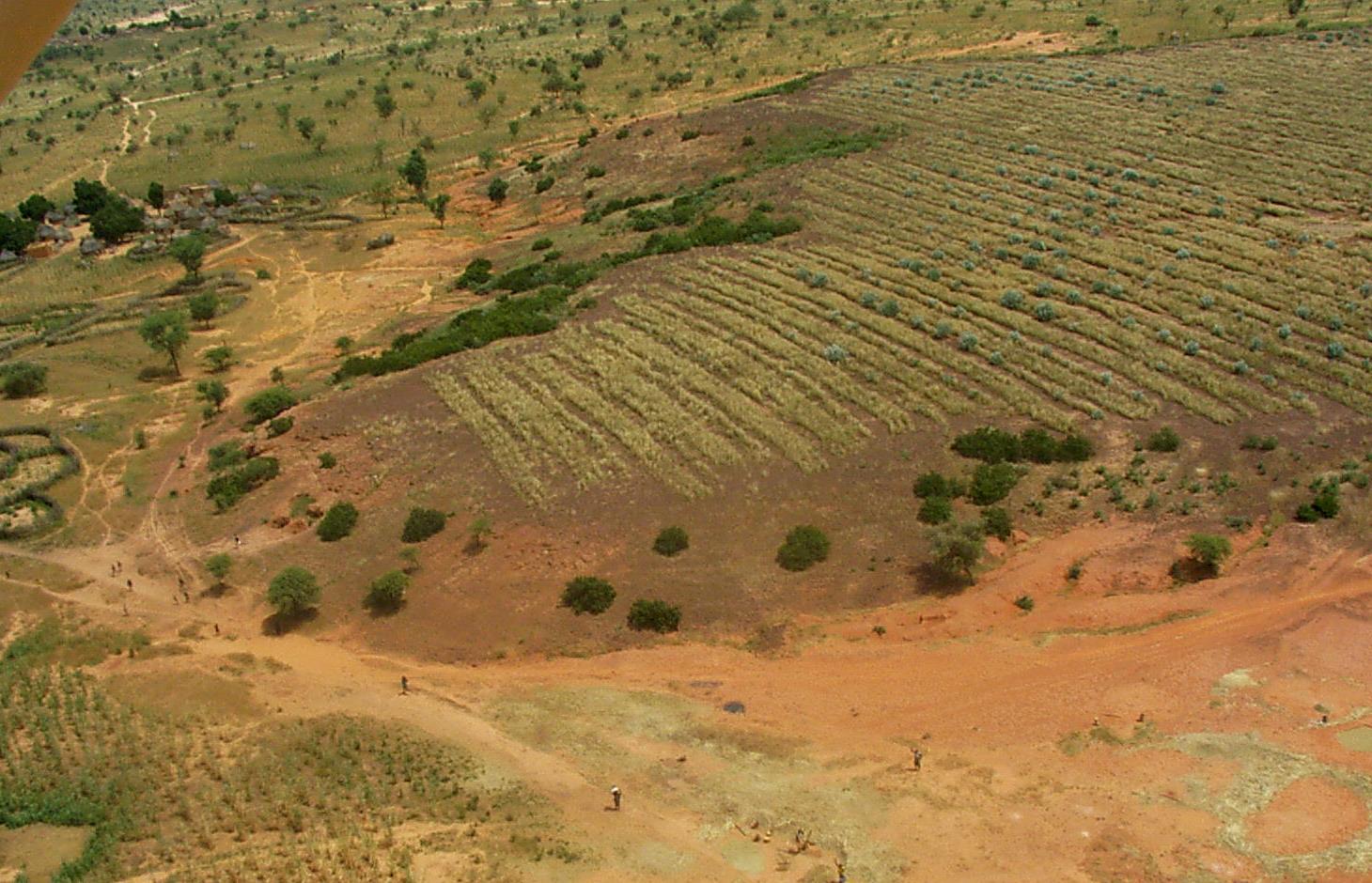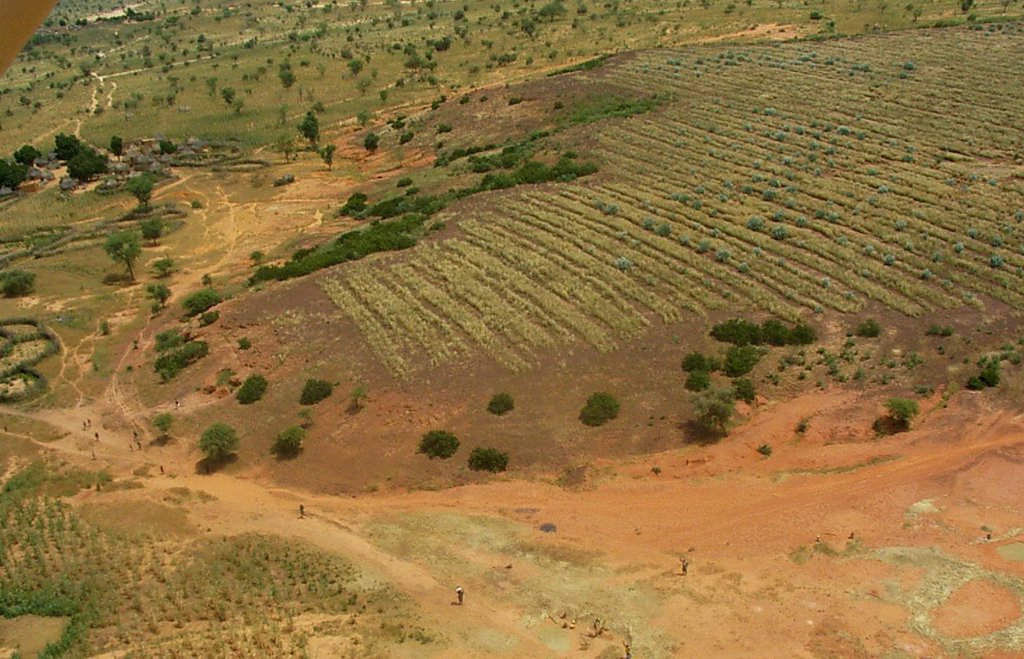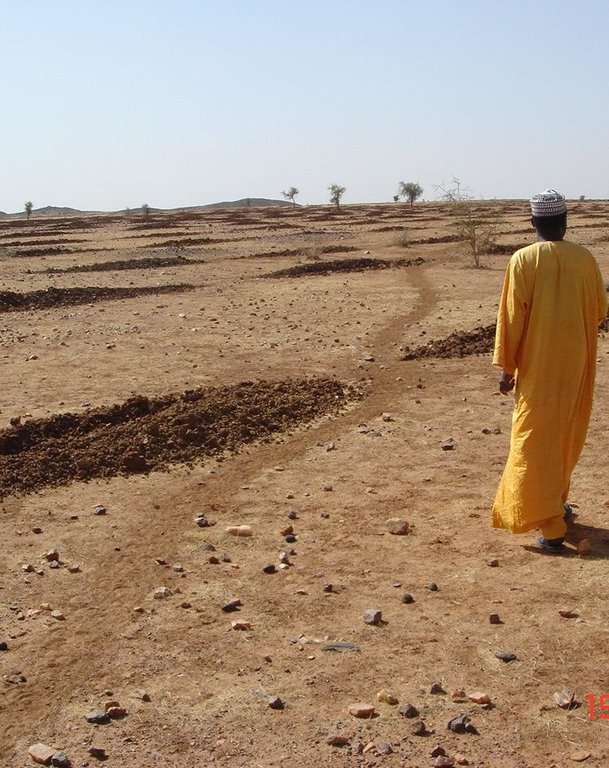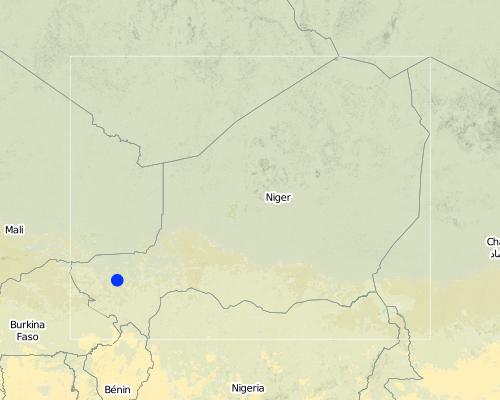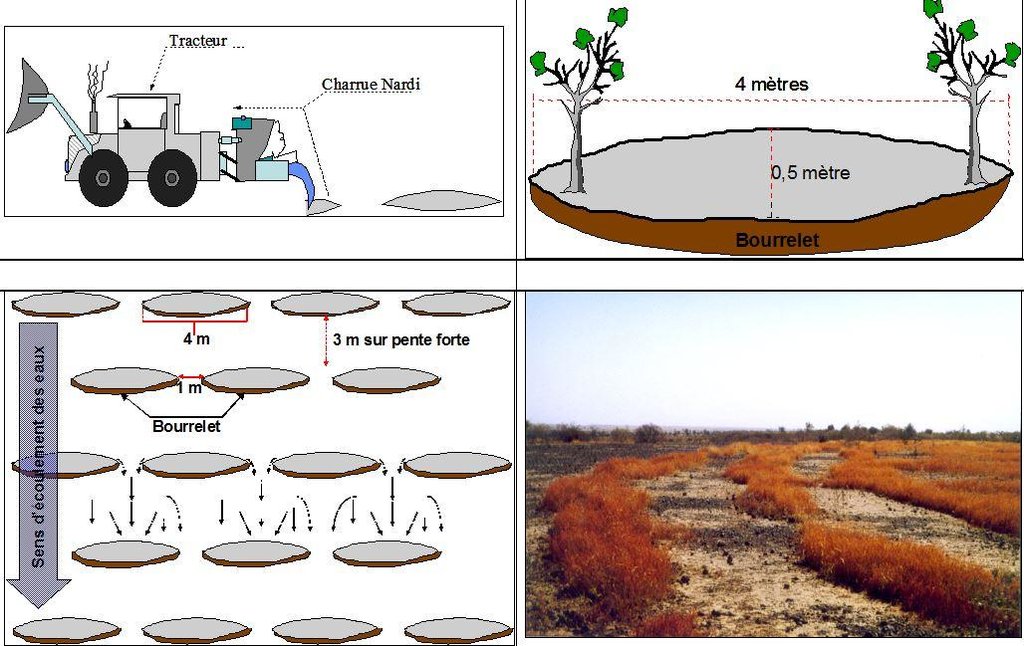Nardi/Vallerani trenches [Нигер]
- Создание:
- Обновить:
- Составитель: Dieter Nill
- Редактор: –
- Рецензент: Deborah Niggli
Tranchées Nardi (French)
technologies_1613 - Нигер
Просмотреть разделы
Развернуть все Свернуть все1. Общая информация
1.2 Контактные данные специалистов и организаций, участвующих в описании и оценке Технологии
Название проекта, содействовавшего документированию/оценке Технологии (если применимо)
Good Practices in Soil and Water Conservation - A contribution to adaptation and farmers ́ resilience towards climate change in the Sahel (GIZ)Название организации (-ий), содействовавших документированию/оценке Технологии (если применимо)
Deutsche Gesellschaft für Internationale Zusammenarbeit (GIZ) GmbH (GIZ) - Германия1.3 Условия, регламентирующие использование данных, собранных ВОКАТ
Когда были собраны данные (на местах)?
01/07/2012
Составитель и ответственный(-ые) специалист(-ы) согласны с условиями, регламентирующими использование собранных ВОКАТ данных:
Да
1.4 Декларация по устойчивости описываемой Технологии
Вызывает ли описанная здесь Технология проблемы деградации земель настолько, что ее нельзя назвать природосберегающей?
Нет
2. Описание Технологии УЗП
2.1 Краткое описание Технологии
Определение Технологии:
Nardi/Vallerani trenches are microcatchments which are made using a special tractor-pulled plough to restore degraded and encrusted forests and rangelands
2.2 Подробное описание Технологии
Описание:
Nardi/Vallerani trenches are microcatchments 4 m long and 0.5 m wide. They are made using a tractor-pulled plough specifically designed for this purpose. The Nardi plough cuts a furrow perpendicular to the slope, throwing up a ridge on the downhill side and thereby creating a barrier on that side of the furrow. The number of trenches varies according to the gradient of the terrain and the type of soil: the recommended number of microcatchments for flat or gently sloping terrain is between 250 and 400 per hectare, with the rows spaced 5 to 7 m apart; and for steeper slopes, the rows should be spaced 3 to 4 m apart, with a density of up to 600 microcatchments per hectare. In each Nardi/Vallerani microcatchment, two or three trees are planted or sown by direct seeding and then separated when they come up. Perennial grasses are sown a year later to allow the trees to become established first. The choice of species largely depends on the use to which the improved land is to be put and the priorities of the beneficiaries. It is recommended that the improved site be protected from grazing animals for at least three years to give the trees time to grow and the grass time to reproduce naturally, although the exact amount of time required will depend on the type of trees planted and how degraded the site is.
Nardi/Vallerani trenches are generally combined with scarification, which is carried out using a tractor-pulled scarifier. The strips between the trenches are scarified a year after they have been dug. These scarified strips are sown with perennial grasses at the same time as the trenches. The trees planted the year before are a year old, and the risk of the saplings being choked by the grass is minimal.
Runoff collects in the Vallerani microcatchments, improving the infiltration of water into the soil and the retention of water for the plants growing in them. They also serve to loosen the soil and improve the plants’ access to nutrients. Windborne seeds are trapped in the microcatchments, which helps to build up the natural grass cover.
This technique is particularly effective when rainfall is low, as the microcatchments retain water and make it available to the plants growing in them.
In the medium term, this technique is effective in protecting the land against water and wind erosion and rehabilitating barren land with no vegetation. In wet years, the microcatchments protect the land downhill from excessive run- off by retaining part of the water.
Implemented on a wide scale, this technique can extend and improve the quality of forest and rangeland and reduce the problems for livestock keepers in years when the quality of pasture is not good. In the medium and long- term, the technique can increase the supply of firewood, timber and other wood products. Even in the short term, it increases the production of straw, which can be used as forage, for making roofing and mats or sold to generate extra income.
Establishment / maintenance activities and inputs: In order to ensure the sustainability of the investment, it is necessary to take the following steps before constructing the trenches: ensure that the communities are motivated to invest in the measure; ensure that the communities have the capacity to do the work and the technical expertise required to implement the measures and develop and manage the sites; ensure that there are sufficiently strong local and regional markets for forest/rangeland products; clearly define the objective (intended uses after improvement); clarify ownership of the land to be improved; jointly define who the beneficiaries will be; formulate an agreement establishing rules governing the protection, use and upkeep of the site.
The right grass species must be chosen to ensure the successful establishment of vegetation cover, taking the following factors into consideration: needs of livestock keepers and/or agro-pastoralists; species suited to environmental conditions, taking into account climate changes; palatability and nutritive value of the species and any secondary uses they may have; availability of seeds; potential for marketing products.
The Sahel is a region where the population has always faced a high degree of climate variability, manifested both in terms of time (unexpected dry spells can occur during the rainy season) and in terms of space (rainfall can vary greatly from one area to another). The population is mainly composed of small farmers and livestock keepers.
Over the last two decades, the effects of climate change have exacerbated the already difficult conditions. Accord¬ing to projections made by climatologists, the Sahel will experience a rise in temperatures combined with highly variable rainfall and an increase in extreme weather events.
The Soil and Water conservation and rehabilitation techniques have helped people in the Sahel to manage their ecosystems more effectively and improve their productive land. As a result, communities are better prepared to cope with environmental changes (changes in the climate, land degradation, etc.) and the im¬pact of shocks, particularly droughts
2.3 Фотографии, иллюстрирующие Технологию
2.5 Страна/ регион/ места, где применяется Технология, информация о которых собрана в данной Анкете
Страна:
Нигер
Административная единица (Район/Область):
Niger
Более точная привязка места:
Regions of Tillabéri, Filingué, Ouallam, Téra and Tahuoa
Map
×2.6 Сколько лет применяется данная Технология
Если год начала применения Технологии достоверно неизвестен, дайте примерную оценку:
- 10-50 лет назад
2.7 Внедрение Технологии
Укажите, как именно Технология УЗП была внедрена:
- через проекты/ внешнее вмешательство
Пояснения (тип проекта и т.д.):
developed, implemented and disseminated as part of projects and programmes undertaken from the 1980s onwards to combat desertification and improve natural resource management. Implemented by GIZ (German Federal Enterprise for International Cooperation), PDRT (Projet de développement rural de Tahoua - Tahoua Rural Development Project), PASP (Projet de protection intégrée des ressources agro-sylvo-pastorales Tillabéri-Nord - Project for the Integrated Protection of Agricultural, Forest and Rangeland Resources in Tillabéri-Nord)
3. Классификация Технологии УЗП
3.1 Основные цели и задачи реализации Технологии
- снижение или предотвращение деградации земель, восстановление нарушенных земель
3.2 Текущий(-ие) тип(-ы) землепользования на территории, где применяется Технология

Пастбищные угодья
Пастбищные земли, экстенсивный выпас:
- Полукочевое/ отгонное животноводство
Интенсивный выпас/ выращивание кормов:
- Стойловое содержание/ нулевой выпас

Леса/ лесистая местность
(Квази-) Природные леса/ лесные массивы:
- Выборочные рубки
Продукции и услуги:
- Древесина
- Дрова
- Плоды и орехи
- Другие продукты леса
- Выпас/ ощипывание молодых побегов и листьев
Пояснения:
Major land use problems (compiler’s opinion): crusting, surface runoff, water and wind erosion, unadapted land use methods, rapidly growing population increasing pressure on land, reduced or abandoned fallow periods, insecure access to land.
Farmers are mainly agropastoralists with some communities specialised on pure pastoralism
Constraints of forested government-owned land or commons
3.3 Дополнительная информация о землепользовании
Обеспеченность водой участков, где реализуется Технология :
- сочетание богарных и орошаемых земель
Число урожаев за год:
- 1
Поясните:
Longest growing period in days: 120, Longest growing period from month to month: August to October
Поголовье скота на единицу площади (если применимо):
1-10 LU /km2
3.4 Категория УЗП, к которой относится Технология
- Улучшение почвенного/ растительного покрова
- Минимальная обработка почв
- мероприятия по влагозадержанию и снижению эрозии почв на склонах
3.6 Мероприятия УЗП, выполняемые в рамках Технологии

Мероприятия с использованием растительности
- Р1: Древесный и кустарниковый покров
- Р2: Злаковые и многолетние травянистые растения

инженерные мероприятия
- И4: Выровненные и спланированные канавы, ямы
3.7 Основные проблемы деградации земель, на решение которых направлена Технология

водная эрозия почв
- ВЭп: поверхностная эрозия/смыв верхних почвенных горизонтов
- ВЭд: косвенное воздействие водной эрозии

ветровая эрозия почв
- Эп: утрата плодородного слоя почвы

ухудшение химических свойств почв
- Хп: Снижение плодородия и уменьшение содержания органического вещества (вызванное не эрозией, а другими причинами)

ухудшение физических свойств почв
- Фу: уплотнение
- Фк: растрескивание и коркообразование

биологическая деградация
- Бр: сокращение растительного покрова

деградация водных ресурсов
- Ва: почвенная засуха
Пояснения:
Main causes of degradation: soil management (Unadapted land use methods, reduced or abandoned fallow periods), crop management (annual, perennial, tree/shrub) (Neglect of fallow periods and crop rotation), droughts (due to heat waves), population pressure (rapidly growing population increasing pressure on land), land tenure (insecure access to land and collectively managaed commons), poverty / wealth (very poor population)
Secondary causes of degradation: deforestation / removal of natural vegetation (incl. forest fires) (deforestation through overgrazing and fire wood collection), over-exploitation of vegetation for domestic use (firewood collection), overgrazing (cattle, shee and goats), change in temperature (Climate change: heat waves), change of seasonal rainfall (more variable onset of rain), Heavy / extreme rainfall (intensity/amounts) (more variable and intensive rains), wind storms / dust storms (frequent storms), floods (due to intensive rains), labour availability (some migration of men to nearby cities), education, access to knowledge and support services (high level of illiteracy)
3.8 Предотвращение и снижение деградации земель, или восстановление нарушенных земель
Укажите цель Технологии по отношению к деградации земель :
- снижение деградации земель
- восстановление/ реабилитация нарушенных земель
4. Технические характеристики, мероприятия по практической реализации, вложения и стоимость
4.1 Технический рисунок, иллюстрирующий Технологию
4.2 Спецификация / пояснения к техническому рисунку
Nardi/Vallerani trenches are microcatchments 4 m long and 0.5 m wide. The Nardi plough cuts a furrow perpendicular to the slope, throwing up a ridge on the downhill side and thereby creating a barrier on that side of the furrow. The recommended number of microcatchments for flat or gently sloping terrain is between 250 and 400 per hectare, with the rows spaced 5 to 7 m apart; and for steeper slopes, the rows should be spaced 3 to 4 m apart, with a density of up to 600 microcatchments per hectare.
Source of drawing: Ministère du Développement Agricole Niger (without date): Recueil des fiches techniques en gestion des ressources naturelles et de productions agro-sylvo-pastorales.
Location: Niger
Technical knowledge required for field staff / advisors: high
Technical knowledge required for land users: moderate
Main technical functions: control of dispersed runoff: retain / trap, control of dispersed runoff: impede / retard, control of concentrated runoff: retain / trap, control of concentrated runoff: impede / retard, improvement of ground cover, improvement of surface structure (crusting, sealing), improvement of topsoil structure (compaction), increase of infiltration, increase / maintain water stored in soil, water harvesting / increase water supply
Secondary technical functions: stabilisation of soil (eg by tree roots against land slides), increase in nutrient availability (supply, recycling,…), sediment retention / trapping, sediment harvesting, reduction in wind speed, promotion of vegetation species and varieties (quality, eg palatable fodder)
Vegetative measure: within each microcatchment 2-3 trees
Vegetative material: T : trees / shrubs, G : grass
Number of plants per (ha): 700-1250
Vegetative measure: Vegetative material: T : trees / shrubs, G : grass
Retention/infiltration ditch/pit, sediment/sand trap
Spacing between structures (m): 5-7
Depth of ditches/pits/dams (m): 0.4
Width of ditches/pits/dams (m): 0.5
Length of ditches/pits/dams (m): 4
Vegetation is used for stabilisation of structures.
4.3 Общая информация по необходимым вложениям и стоимости
другая/ национальная валюта (название):
CFA Franc
Укажите обменный курс между долларом США и местной валютой (если уместно): 1 доллар США =:
521,18
4.4 Мероприятия, необходимые для начала реализации
| Деятельность | Тип мероприятия | Сроки | |
|---|---|---|---|
| 1. | The Nardi plough cuts a furrow perpendicular to the slope, throwing up a ridge on the downhill side and thereby creating a barrier on that side of the furrow | Инженерные | |
| 2. | In each Nardi/Vallerani microcatchment, two or three trees are planted or sown by direct seeding | Мероприятия с использованием растительности |
4.5 Вложения и затраты, необходимые для начала реализации
| Опишите затраты | Единица | Количество | Затраты на единицу | Общая стоимость на единицу | % затрат, оплаченных землепользователями | |
|---|---|---|---|---|---|---|
| Оплата труда | labour | ha | 1,0 | 16,3 | 16,3 | 100,0 |
| Оборудование | machine use | ha | 1,0 | 23,6 | 23,6 | 100,0 |
| Оборудование | transport and planting trees | ha | 1,0 | 12,3 | 12,3 | 100,0 |
| Посадочный материал | seedlings | ha | 1,0 | 52,0 | 52,0 | 100,0 |
| Общая стоимость запуска Технологии | 104,2 | |||||
4.6 Поддержание/ текущее обслуживание
| Деятельность | Тип мероприятия | Сроки/ повторяемость проведения | |
|---|---|---|---|
| 1. | Separating trees when they come up | Мероприятия с использованием растительности | |
| 2. | Perennial grasses are sown a year after the trees to allow the trees to become established first. | Мероприятия с использованием растительности | |
| 3. | The strips between the trenches are scarifieda year after they have been dug. These scarified strips are sown with perennial grasses at the same time as the trenches. | Мероприятия с использованием растительности |
4.7 Стоимость поддержания/ текущего обслуживания ( в год)
Пояснения:
Microcatchments on low-gradient terrain
• 1 Nardi plough (imported from Italy)
• tractor hire.
Labour
• 8.5 man-days per ha.
Other costs
• 800 seedlings and 15 kg of seeds (plus transport and replacement plants).
4.8 Наиболее значимые факторы, влияющие на стоимость затрат
Опишите наиболее значимые факторы, влияющие на стоимость затрат:
The slope determines the costs. The number of trenches varies according to the gradient of the terrain and the type of soil: the recommended number of microcatchments for flat or gently sloping terrain is between 250 and 400 per hectare, with the rows spaced 5 to 7 m apart; and for steeper slopes, the rows should be spaced 3 to 4 m apart, with a density of up to 600 microcatchments per hectare.
5. Природные и социально-экономические условия
5.1 Климат
Среднегодовое количество осадков
- < 250 мм
- 251-500 мм
- 501-750 мм
- 751-1000 мм
- 1001-1500 мм
- 1501-2000 мм
- 2001-3000 мм
- 3001-4000 мм
- > 4000 мм
Агроклиматическая зона
- полузасушливая
Thermal climate class: subtropics
5.2 Рельеф
Склоны (преобладающие):
- пологие (0-2%)
- покатые (3-5%)
- покато-крутые (6-10%)
- крутые (11-15%)
- очень крутые (16-30%)
- чрезвычайно крутые (31-60%)
- обрывистые (>60%)
Формы рельефа:
- плато/ равнины
- гребни хребтов/холмов
- склоны гор
- склоны холмов
- подножья
- днища долин
Зона высотной поясности:
- 0-100 м над уровнем моря
- 101-500 м н.у.м.
- 501-1000 м н.у.м.
- 1001-1500 м н.у.м.
- 1501-2000 м н.у.м.
- 2001-2500 м н.у.м.
- 2501-3000 м н.у.м.
- 3001-4000 м н.у.м.
- > 4 тыс. м н.у.м.
5.3 Почвы
Средняя мощность почв:
- поверхностные (0-20 см)
- неглубокие (21-50 см)
- умеренно глубокие (51-80 см)
- глубокие (81-120 см)
- очень глубокие (> 120 см)
Гранулометрический состав (верхнего горизонта):
- средние фракции (суглинистый, супесчаный)
- тонкодисперсный/ тяжёлый (глинистый)
Содержание органического вещества в верхнем горизонте:
- среднее (1-3%)
5.4 Доступность и качество воды
Уровень грунтовых вод:
5-50 м
Доступность поверхностных вод:
средняя
Качество воды (без обработки):
исключительно для сельскохозяйственного использования (орошение)
5.5 Биоразнообразие
Видовое разнообразие:
- низкое
5.6 Характеристика землепользователей, применяющих Технологию
Рыночная ориентация производства:
- натуральное хозяйство (самообеспечение)
- смешанное (самообеспечение/ товарное хозяйство
Доходы из других источников:
- 10-50% всех доходов
Относительный уровень достатка:
- очень плохой
- плохой
Уровень механизации:
- ручной труд
- тягловая сила
Пол:
- мужчины
Укажите другие важные характеристики землепользователей:
Population density: 10-50 persons/km2
Annual population growth: 3% - 4% (mostly poor households below poverty line).
Off-farm income specification: men migrate temporarily or permanently to cities for off-farm income, women and men seasonally carry out paid farm work
5.7 Средний размер земельных участков, арендуемых или находящихся в собственности землепользователей, применяющих Технологию
- < 0,5 га
- 0,5-1 га
- 1-2 га
- 2-5 га
- 5-15 га
- 15-50 га
- 50-100 га
- 100-500 га
- 500-1000 га
- 1000-10000 га
- > 10000 га
Считается ли это мелким, средним или крупным хозяйством (по местным масштабам)?
- мелкое
5.8 Собственность на землю, права на земле- и водопользование
Землевладелец:
- государственная
- общинная/ поселковая
Право землепользования:
- неограниченное (неконтролируемое)
- общинное (контролируемое)
Право водопользования:
- неограниченное (неконтролируемое)
- общинное (контролируемое)
Пояснения:
traditional land use rights prevail. On fields individual land use rights, communal land on pasture and forest land (collection of wood and other products (fruits, medicinal plants))
5.9 Доступ к базовым услугам и инфраструктуре
медицинское обслуживание:
- плохой
- средний
- хорошая
образование:
- плохой
- средний
- хорошая
технические консультации:
- плохой
- средний
- хорошая
занятость (вне хозяйства):
- плохой
- средний
- хорошая
рынки:
- плохой
- средний
- хорошая
электроснабжение:
- плохой
- средний
- хорошая
транспорт и дорожная сеть:
- плохой
- средний
- хорошая
водоснабжение и канализация:
- плохой
- средний
- хорошая
финансовые услуги:
- плохой
- средний
- хорошая
6. Воздействия и заключительные положения
6.1 Влияние Технологии УЗП в пределах территории ее применения
Социально-экономическое воздействие
Продуктивность
производство кормов
качество кормов
производство продуктов животноводства
Комментарий/ пояснения:
It is recommended that the improved site be protected from grazing animals for at least three years to give the trees time to grow and the grass time to reproduce naturally
производство древесины
площадь, используемая для производства продукции
Доходы и затраты
доходы хозяйства
Другое социально-экономическое воздействие
amount of straw (used as forage or sold and/or used for roofing, doors and fencing)
Социальное и культурное воздействие
продовольственная безопасность/ самообеспечение
смягчение конфликтов
contribution to human well-being
Комментарий/ пояснения:
Implemented on a wide scale, this technique can extend and improve the quality of forest and rangeland and reduce the problems for livestock keepers in years when the quality of pasture is not good. In the medium and long-term, the technique can increase the supply of firewood, timber and other wood products. Even in the short term, this technique increases the production of straw, which can be used as forage, for making roofing and mats or sold to generate extra income. The forest/rangeland sites help communities to bridge the hunger gap, and in lean years, the women collect forest products, such as leaves, pods and fruit to supplement their diet. Sometimes, small quantities of wood are sold to buy cereals. Ingredients for medicinal products and other secondary products, such as gum arabic, are collected from the trees and bushes.
Экологическое воздействие
Водный цикл/ поверхностный сток
сбор воды/ водоудержание
поверхностный сток
Почвы
влажность почв
почвенный покров
утрата почв
образование корки на поверхности почв/ запечатывание
уплотнение почв
круговорот/ восполнение питательных веществ
Биоразнообразие: растительность, животный мир
биомасса/ содержание углерода в надземной биомассе
Количество до применения УЗП :
100 kg/ha
Количество после применения УЗП:
540 kg/ha
разнообразие флоры
Климат и снижение риска стихийных бедствий
скорость ветра
6.2 Влияние Технологии за пределами территории ее применения
подтопление ниже по течению
отложения, переносимые ветром
6.3 Подверженность и чувствительность Технологии УЗП к постепенным изменениям климата и экстремальным погодным явлениям/ стихийным бедствиям, связанным с изменением климата (в понимании землепользователей)
Постепенное изменение климата
Постепенное изменение климата
| Сезон | Тип изменения климата/ экстремального явления | Насколько успешно Технология справляется с этим? | |
|---|---|---|---|
| среднегодовые температуры | увеличилось | хорошо |
Экстремальные явления, связанные с изменением климата (стихийные бедствия)
Погодные стихийные бедствия
| Насколько успешно Технология справляется с этим? | |
|---|---|
| местные ливневые дожди | плохо |
| местные ураганы | хорошо |
Стихийные бедствия климатического характера
| Насколько успешно Технология справляется с этим? | |
|---|---|
| засухи | хорошо |
Гидрологические стихийные бедствия
| Насколько успешно Технология справляется с этим? | |
|---|---|
| регулярные наводнения (выход рек из берегов) | плохо |
Пояснения:
Physical structures can be biologically stabilized through planting of grass, bushes or trees. Damages are generally small but need to be repaired quickly.
6.4 Анализ эффективности затрат
Насколько получаемый результат сопоставим с первоначальными вложениями (с точки зрения землепользователей)?
Эффективность затрат в краткосрочной перспективе:
позитивное
Эффективность затрат в долгосрочной перспективе:
очень позитивное
Насколько получаемый результат сопоставим с текущими расходами по поддержанию технологии (с точки зрения землепользователей)?
Эффективность затрат в краткосрочной перспективе:
позитивное
Эффективность затрат в долгосрочной перспективе:
очень позитивное
Пояснения:
In the short term, this technique increases the production of straw, which can be used as forage, for making roofing and mats or sold to generate extra income. In the medium and long-term, the technique can increase the supply of firewood, timber and other wood products.
6.5 Внедрение Технологии
Пояснения:
The techniques were implemented with food for work in the 1990s to 2000. At the end, the work provided by land users was not compensated. Only small equipment and transportation were provided for free. Some adoption (without support by the project) has been observed in some places.
There is a little trend towards spontaneous adoption of the Technology. Some adoption (without support by the project) has been observed in some places.
6.7 Сильные стороны/ преимущества/ возможности Технологии
| Сильные стороны/ преимущества/ возможности по мнению составителя или других ключевых специалистов |
|---|
| In the medium term, this technique is effective in protecting the land against water and wind erosion and rehabilitating barren land with no vegetation. |
| Runoff collects in the Vallerani microcatchments, improving the infiltration of water into the soil and the retention of water for the plants growing in them. They also serve to loosen the soil and improve the plants’ access to nutrients. Windborne seeds are trapped in the microcatchments, which helps to build up the natural grass cover. |
| In wet years, the micro-catchments protect the land downhill from excessive runoff by retaining part of the water. |
| This technique is particularly effective when rainfall is low, as the microcatchments retain water and make it available to the plants growing within them. |
| The average additional output of dry matter in the form of herbaceous biomass was approximately 540 kg/ha, compared with less than 100 kg per hectare on land where the technique was not applied |
6.8 Слабые стороны/ недостатки/ риски Технологии и пути их преодоления
| Слабые стороны/ недостатки/ риски по мнению составителя или ответственных специалистов | Возможные пути их преодоления/снижения? |
|---|---|
| Animal production is reduced because the improved site should be protected from grazing animals for at least three years to give the trees time to grow and the grass time to reproduce naturally | |
| Vallerani microcatchments are recommended for use on well-structured soils (soils with high clay content and lateritic and stony soils). On poorly structured soils (sandy, silty soils), the furrows tend to close over after the first rains, rendering them ineffective. | |
| The Acacia holosericea species is not considered suitable for reforestation purposes, owing to its limited life span. |
7. Справочные материалы и ссылки
7.1 Методы сбора/ источники информации
- выезды на места, полевые обследования
- опросы землепользователей
7.2 Ссылки на опубликованные материалы
Название, автор, год публикации, ISBN:
Good Practices in Soil and Water Conservation. A contribution to adaptation and farmers´ resilience towards climate change in the Sahel. Published by GIZ in 2012.
Где опубликовано? Стоимость?
http://agriwaterpedia.info/wiki/Main_Page
Ссылки и модули
Развернуть все Свернуть всеСсылки
Нет ссылок
Модули
Нет модулей


